Recently I'm working on bone animation import, so I made a 3d minecraft-like model with some IK technique to test Assimp animation import. Ouput format is COLLADA(*.dae),and the tool I used is Blender. On the programming side, my enviroment is opengl/glm/assimp. I think these information for my problem is enough.One thing, the animation of the model, I just record 7 unmove keyframe for testing assimp animation.
First, I guess my transformation except local transform part is correct, so let the function only return glm::mat4(1.0f), and the result show the bind pose(not sure) model. (see below image)
Second, Turn back the value glm::mat4(1.0f) to bone->localTransform = transform * scaling * glm::mat4(1.0f);, then the model deform. (see below image)
Test image and model in blender:
 (
(bone->localTransform = glm::mat4(1.0f) * scaling * rotate; : this image is under ground :( )
The code here:
void MeshModel::UpdateAnimations(float time, std::vector<Bone*>& bones)
{
for each (Bone* bone in bones)
{
glm::mat4 rotate = GetInterpolateRotation(time, bone->rotationKeys);
glm::mat4 transform = GetInterpolateTransform(time, bone->transformKeys);
glm::mat4 scaling = GetInterpolateScaling(time, bone->scalingKeys);
//bone->localTransform = transform * scaling * glm::mat4(1.0f);
//bone->localTransform = glm::mat4(1.0f) * scaling * rotate;
//bone->localTransform = glm::translate(glm::mat4(1.0f), glm::vec3(0.5f));
bone->localTransform = glm::mat4(1.0f);
}
}
void MeshModel::UpdateBone(Bone * bone)
{
glm::mat4 parentTransform = bone->getParentTransform();
bone->nodeTransform = parentTransform
* bone->transform // assimp_node->mTransformation
* bone->localTransform; // T S R matrix
bone->finalTransform = globalInverse
* bone->nodeTransform
* bone->inverseBindPoseMatrix; // ai_mesh->mBones[i]->mOffsetMatrix
for (int i = 0; i < (int)bone->children.size(); i++) {
UpdateBone(bone->children[i]);
}
}
glm::mat4 Bone::getParentTransform()
{
if (this->parent != nullptr)
return parent->nodeTransform;
else
return glm::mat4(1.0f);
}
glm::mat4 MeshModel::GetInterpolateRotation(float time, std::vector<BoneKey>& keys)
{
// we need at least two values to interpolate...
if ((int)keys.size() == 0) {
return glm::mat4(1.0f);
}
if ((int)keys.size() == 1) {
return glm::mat4_cast(keys[0].rotation);
}
int rotationIndex = FindBestTimeIndex(time, keys);
int nextRotationIndex = (rotationIndex + 1);
assert(nextRotationIndex < (int)keys.size());
float DeltaTime = (float)(keys[nextRotationIndex].time - keys[rotationIndex].time);
float Factor = (time - (float)keys[rotationIndex].time) / DeltaTime;
if (Factor < 0.0f)
Factor = 0.0f;
if (Factor > 1.0f)
Factor = 1.0f;
assert(Factor >= 0.0f && Factor <= 1.0f);
const glm::quat& startRotationQ = keys[rotationIndex].rotation;
const glm::quat& endRotationQ = keys[nextRotationIndex].rotation;
glm::quat interpolateQ = glm::lerp(endRotationQ, startRotationQ, Factor);
interpolateQ = glm::normalize(interpolateQ);
return glm::mat4_cast(interpolateQ);
}
glm::mat4 MeshModel::GetInterpolateTransform(float time, std::vector<BoneKey>& keys)
{
// we need at least two values to interpolate...
if ((int)keys.size() == 0) {
return glm::mat4(1.0f);
}
if ((int)keys.size() == 1) {
return glm::translate(glm::mat4(1.0f), keys[0].vector);
}
int translateIndex = FindBestTimeIndex(time, keys);
int nextTranslateIndex = (translateIndex + 1);
assert(nextTranslateIndex < (int)keys.size());
float DeltaTime = (float)(keys[nextTranslateIndex].time - keys[translateIndex].time);
float Factor = (time - (float)keys[translateIndex].time) / DeltaTime;
if (Factor < 0.0f)
Factor = 0.0f;
if (Factor > 1.0f)
Factor = 1.0f;
assert(Factor >= 0.0f && Factor <= 1.0f);
const glm::vec3& startTranslate = keys[translateIndex].vector;
const glm::vec3& endTrabslate = keys[nextTranslateIndex].vector;
glm::vec3 delta = endTrabslate - startTranslate;
glm::vec3 resultVec = startTranslate + delta * Factor;
return glm::translate(glm::mat4(1.0f), resultVec);
}
The code idea is referenced from Matrix calculations for gpu skinning and Skeletal Animation With Assimp.
Overall, I fectch all the information from assimp to MeshModel and save it to the bone structure, so I think the information is alright?
The last thing, my vertex shader code:
#version 330 core
#define MAX_BONES_PER_VERTEX 4
in vec3 position;
in vec2 texCoord;
in vec3 normal;
in ivec4 boneID;
in vec4 boneWeight;
const int MAX_BONES = 100;
uniform mat4 model;
uniform mat4 view;
uniform mat4 projection;
uniform mat4 boneTransform[MAX_BONES];
out vec3 FragPos;
out vec3 Normal;
out vec2 TexCoords;
out float Visibility;
const float density = 0.007f;
const float gradient = 1.5f;
void main()
{
mat4 boneTransformation = boneTransform[boneID[0]] * boneWeight[0];
boneTransformation += boneTransform[boneID[1]] * boneWeight[1];
boneTransformation += boneTransform[boneID[2]] * boneWeight[2];
boneTransformation += boneTransform[boneID[3]] * boneWeight[3];
vec3 usingPosition = (boneTransformation * vec4(position, 1.0)).xyz;
vec3 usingNormal = (boneTransformation * vec4(normal, 1.0)).xyz;
vec4 viewPos = view * model * vec4(usingPosition, 1.0);
gl_Position = projection * viewPos;
FragPos = vec3(model * vec4(usingPosition, 1.0f));
Normal = mat3(transpose(inverse(model))) * usingNormal;
TexCoords = texCoord;
float distance = length(viewPos.xyz);
Visibility = exp(-pow(distance * density, gradient));
Visibility = clamp(Visibility, 0.0f, 1.0f);
}
If my question above, lack of code or describe vaguely, please let me know, Thanks!
Edit:(1)
In additional, my bone information like this(code fetching part):
for (int i = 0; i < (int)nodeAnim->mNumPositionKeys; i++)
{
BoneKey key;
key.time = nodeAnim->mPositionKeys[i].mTime;
aiVector3D vec = nodeAnim->mPositionKeys[i].mValue;
key.vector = glm::vec3(vec.x, vec.y, vec.z);
currentBone->transformKeys.push_back(key);
}
had some transformation vector, so my code above glm::mat4 transform = GetInterpolateTransform(time, bone->transformKeys);,Absloutely, get the same value from it. I'm not sure I made a nomove keyframe animation that provide the transform values is true or not (of course it has 7 keyframe).
A keyframe contents like this(debug on head bone):
 7 different keyframe, same vector value.
7 different keyframe, same vector value.
Edit:(2)
If you want to test my dae file, I put it in jsfiddle, come and take it :). Another thing, in Unity my file work correctly, so I think maybe not my local transform occurs the problem, it seems the problem could be some other like parentTransform or bone->transform...etc? I aslo add local transform matrix with all bone, But can not figure out why COLLADA contains these value for my unmove animation...

